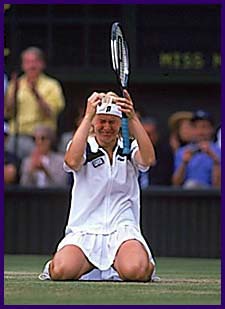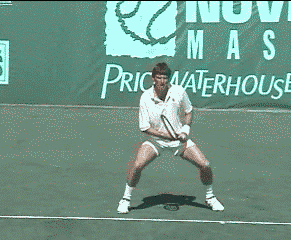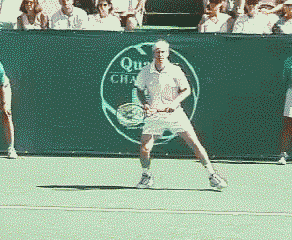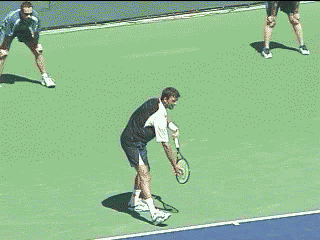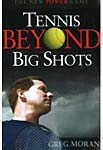| TennisOne Lessons Conquering our Inner Devil Greg Moran
How many times have you said to yourself after a particularly horrendous error: "Why did I try that crazy shot when all I needed to do was get the ball back in the court?" Chances are, the reason you tried that “crazy” shot was that your Tennis Devil got the better of you. For many players, particularly those of us between the 2.0-3.5 levels, our toughest competition doesn’t come from the player standing on the opposite side of the net but rather the opposition between our ears. I call it our Tennis Devil and when the match gets tight or things don’t go our way, he springs to life and uses his weapons: impatience, anger, and fear to take over our minds and destroy our games. When our Devil takes over, we begin to try low percentage shots, committing one unforced error after another. We angrily slam balls into the fence and, when the big point arrives, are so nervous we can’t lift our arms to serve. Before we know it the match is over and we’ve beaten ourselves! Impatience, fear and anger are opponents of us all but with a few simple strategies, we can learn to push them aside and still play a winning game. Polish Up Your Patience
Chris Evert once said that “ninety percent of my game is mental. It's my concentration that has gotten me this far.” Many players struggle with their concentration and, after two or three shots, lose their patience and take unnecessary risks. Consistency drills are a great way to improve your patience (I call it mental endurance) and cut down on your unforced errors. When I was learning the game, I would walk onto the court, warm up, and my coach would say, "Okay, let's start off with 20 crosscourt forehands beyond the service line." I would stand in one corner, my coach in the opposite, and we’d begin to rally, back and forth until we hit 20 in a row beyond the service line. If I accomplished the goal, we moved on to another consistency drill. If not, we kept trying until I did, even if it took the entire hour. Through drills such as these (which I still do nearly forty years later) I developed mental endurance by learning to keep the ball in play for an extended period of time. Do you remember the fabulous Gene Hackman movie “Hoosiers?” Hackman portrayed a down-on-his-luck basketball coach in a small town in Indiana. To teach his out of control team the value of patience, he insisted that, each time down the floor, they pass the ball at least three times before they even thought about taking a shot. To take that concept to the next level, during your next match, tell yourself that you’re going to hit five balls back before trying to win the point. As you hit each shot, actually say to yourself, “one, two, three, four, five.” This will help you increase your level of patience and you’ll also be amazed at how often hitting just a few shots in the court will win the point.
High level players have the mental endurance of a marathoner and are prepared to hit as many shots as it takes to win a point. Patience made Hackman’s Hoosiers winners and it will do the same for you. It’s Tough to Hit the Ball with Your Hands around Your Throat Tennis players come in all shapes, sizes and abilities, but we all have one thing in common—when the pressure is on, our nerves and muscles tighten up and don’t work like they should. Be it a social doubles game, a league match or a tournament final, whenever the score is being kept, the opportunity to get angry at ourselves or “choke” always hovers in the air. There wasn’t a tennis fan in the world that didn’t ache for Jana Novotna after her heartbreaking loss to Steffi Graf in the 1993 Wimbledon ladies singles final. Serving in the third set up 4-1, 40-30, Novotna was just five points away from the games most coveted title when her Tennis Devil got the better of her. A few agonizing minutes later, she collapsed in tears as the Duchess of Kent handed her the runner-up prize. Novotna had choked, big time! We choke because we’re afraid. We’re afraid to lose, afraid of letting down our team and we’re afraid of looking bad in front of our friends and family. John McEnroe, in his autobiography “You Cannot Be Serious” admitted that his intense fear of losing outweighed his love of winning and often fueled his emotional rages. Sometimes, we’re even afraid to win, because if we win we may be expected to win again and who needs that kind of pressure? Once the choking begins it can be like a reoccurring nightmare. Two years after her devastating loss to Graf, Novotna found herself with an even bigger lead in the third round of the 1995 French open. Up 5-0 in the third set against American Chanda Rubin, Novotna’s Devil undoubtedly whispered in her ear, “Remember Wimbledon?” She lost the match. Racquet Rage You’re standing on the court, racquet raised above your head, teeth clenched, muscles tense, a primal scream stirring in your belly. You’ve missed your third consecutive sitter, and the urge to slam dunk your racquet into the court is overwhelming. Anger is the enemy of every tennis player. Broken racquets, balls slammed into (and over) fences and a XXX vocabulary are a few of the most popular responses when our temper gets the better of us. As the errors pile up, the anger increases and the vicious cycle continues until we’ve missed enough shots to lose the match—or break all of our racquets and have to default as happened to touring pro Goran Ivanisevic a few years ago. While John McEnroe and Jimmy Connors were known for being able to make their rage work for them, most of us don’t have that ability. Though anger can sometimes help wake us up when our concentration falters, most of the time, as our temperatures rise, our level of play falls.
Though it is human nature for us to get nervous or angry during the heat of a match, the negative thoughts that accompany these two emotions seldom bring positive results so we need to learn to push them aside and get back on a positive path. The key lies with our inner voice. Taming the Voice Inside Our Heads Did you know that the average person talks to himself, verbally or non-verbally, approximately 50,000 times per day? Or, put another way, every two seconds of our lives we're telling ourselves something. Applying that that information to our tennis lives, during the average three set match (roughly 90 minutes) we send ourselves a little over 3,000 messages and, for some, those messages are largely negative.
Here a few strategies to help you push the bad thoughts aside, keep your emotions in check and relieve some of the inevitable stress that comes with competition.
Dr. John F. Murray, author of Smart Tennis, has devised a great experiment to help us monitor our self-talk. The next time you walk onto the court, place forty paperclips in your right pocket. Each time you catch yourself making a negative comment to yourself, reach into your pocket and transfer one paperclip to the left pocket. At the end of the match see how many clips have gone to the left side. You might be shocked---and motivated to change.
Work at it and, slowly but surely, you'll see a change in the way you speak to yourself and in turn the way you feel about yourself. After a month or two try the paperclip experiment again and see how you've improved. Virtually no one plays well when they lose control of themselves so, even if you’ve made six unforced errors in a row and blown a four game lead, keep your emotions under control. Push aside your desire to demonstrate your vast knowledge of obscenities and the urge to launch your racquet into the parking lot. Take a few deep breaths, repeat some constructive, positive phrases to yourself and move on. In the January/February 2006 issue of TENNIS magazine, trainer Pat Etcheberry described a relaxation exercise in which he has his students play points with a potato chip in their mouths with the goal being to not let the chip break. “This drill makes it obvious when you’re tensing up in your neck and face.” By becoming a more patient player and learning to control your emotions you’ll significantly cut down on your number of unforced errors and will in turn, stop being your own toughest opponent. Your comments are welcome. Let us know what you think about Greg Moran's article by emailing us here at TennisOne.
Tennis Beyond Big Shots presents a bold back-to-the-future approach. A new game that moves away from power and big shots yet is more lethal to opponents than any booming serve. Greg Moran shows players of all ages and abilities that, with simple and small changes, you can not only maximize your tennis wins and play longer, but also have much more fun doing it. Click link to purchase Greg Moran's book, Tennis Beyond Big Shots. Mansion Grove House is pleased to announce that in May 2008, they will release the second edition of Tennis Beyond Big Shots. Written by Greg Moran, the book (which includes a new chapter) was Amazon's #1 new tennis release in 2007. |
